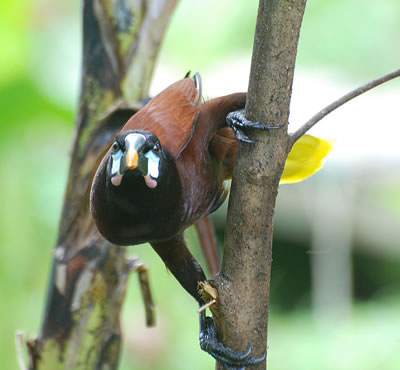Oropendola

Facts about creatures
- Home
- Animal Classification
- Animal Habitats
- Amphibians
- Arthropods
- Bats
- Birds
- Carnivorans
- Cetaceans
- Chordates
- Crustaceans
- Dinosaurs
- Diprotodonts
- Elephants
- Fish
- Golden Mole
- Insects
- Lagomorphs
- Mammals
- Mammal Teeth
- Marsupial Mole
- Metamorphosis
- Mollusks
- Primates
- Reptiles
- Rodents
- Ruminants
- Soricomorphans
- Tenrec
- Tetrapods
- Vertebrates
Oropendola
Oropendolas are a group of passerines that belong to the family Icteridae, which also includes new world orioles.
They live in Central and South America.
Oropendolas are usually brown or black, with tails that have at least some bright yellow.
Their bills are often yellow or red.
They are omnivorous, and eat fruit, nectar and insects.
The name oropendola is Spanish for “gold pendulum”. The name comes from an unusual behavior that the male engages in during courtship displays.
He stands with his claws wrapped around a branch, then spreading his wings and flipping over so that he is hanging upside down, like a pendulum.
Chestnut-Headed Oropendola
The chestnut-headed oropendola, also known as Wagler’s oropendola, is black with a chestnut head and rump a tail that is mostly bright yellow
Its range extends from Mexico to Ecuador.
It lives in forests and old plantations.
Females build hanging sack-like nests made out of vines, fibers and moss.
The nests are hung high in trees.
Chestnut-headed oropendolas live in colonies, so a tree can be full of nests.
There are about five times as many females in a colony as there are males.
Females incubate and raise their young themselves; the males provide no help.

Montezuma Oropendola
The Montezuma oropendola has a range that extends from Mexico to Panama.
It is mostly chestnut colored, with a black head and rump. Its tail is mostly bright yellow.
Its habitat is similar to that of the chestnut-headed oropendola.
It also lives in colonies, with a large number of females compared to males.
Females build hanging nests in trees.